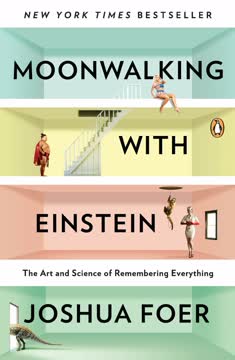Key Takeaways
1. Passion is the foundation of great communication
"People with passion can change the world for the better."
Identify your emotional connection. Great communicators like Howard Schultz of Starbucks radiate authentic enthusiasm for their message. To increase your "Passion Quotient" (PQ):
- Find the deep emotional connection to your story
- Share that enthusiasm with your listeners
- Focus on the broader impact, not just the product (e.g., Schultz's passion for community, not just coffee)
- Remember: passion is contagious and builds rapport with your audience
2. Inspiration drives action and creates lasting impact
"I can inspire people to do things I believe in."
Paint a compelling vision. Like Nelson Mandela's dream of a peaceful Africa, great communicators create a vivid picture of a better future. To inspire your audience:
- Develop a clear "road map" for your vision
- Use stories to make your vision relatable and memorable
- Connect your personal experiences to your message (e.g., Howard Schultz's father's injury story)
- Appeal to emotions and values, not just logic
- Use image-based words to evoke sensory experiences
3. Thorough preparation is key to effective communication
"The more I practice the luckier I get."
Know your audience and material. Great communicators like TED speaker Dr. Jill Bolte Taylor prepare extensively. To enhance your preparation:
- Answer three key questions about your audience:
- What do they need to know?
- Why should they care?
- What action do I want them to take?
- Rehearse your presentation multiple times
- Use video recordings to identify areas for improvement
- Internalize your content to maintain eye contact and engage naturally
4. Start strong to captivate your audience immediately
"A powerful beginning and ending will stick with your listeners."
Craft a compelling opening. Like Barbara Corcoran on Shark Tank, great communicators know the importance of the first 60 seconds. To create a strong start:
- Develop a 30-second "lead" that answers these questions:
- What is my service, product, company, or cause?
- What problem do I solve?
- How am I different?
- Why should you care?
- Make your opening clear, concise, and compelling
- Use a hook, story, or surprising fact to grab attention immediately
5. Clarity and simplicity are essential for powerful messaging
"Any fool can make things more complex. The true genius makes it simpler."
Eliminate jargon and complexity. Great communicators like Jack Welch strive for simplicity. To enhance clarity:
- Ask yourself, "Where's the Wow?" to identify your key message
- Cut unnecessary jargon and buzzwords
- Use simple, one-syllable words when possible
- Break down complex ideas into easily digestible parts
- Use analogies and metaphors to explain difficult concepts
6. Brevity enhances impact and maintains audience engagement
"In history, many of the most powerful talks were short and to the point."
Respect your audience's time. Great communicators like John F. Kennedy keep their messages concise. To improve brevity:
- Aim for the "Window of Impact" of 10-18 minutes
- Cut unnecessary content ruthlessly
- Practice describing your idea in 25 words or less
- Use short sentences and paragraphs
- Focus on your core message and supporting points
7. Deliver your message with style and confidence
"When you change the way you see yourself as a speaker, the speaker your audience sees will change."
Use vocal variety and pacing. Great communicators like Maya Angelou use their voice as an instrument. To enhance your delivery:
- Vary your tone, inflection, and speed to maintain interest
- Use strategic pauses for emphasis
- Enunciate clearly, especially final consonants
- Practice tongue twisters to improve articulation
- Record yourself and analyze your vocal patterns
8. Command presence through body language and demeanor
"[George] Washington's bearing and presence bedazzled people... Washington was, quite simply, a sight to behold."
Project confidence and authority. Great communicators exude "command presence." To improve your non-verbal communication:
- Maintain an open posture:
- Avoid crossing arms or putting hands in pockets
- Don't hide behind podiums or objects
- Make consistent eye contact
- Use purposeful hand gestures at key moments
- Stand tall and move with purpose
- Practice in front of a mirror or on video
9. Appearance matters: Dress for success and credibility
"You should always dress to suit who you are trying to work with."
Look the part. Great communicators like Barbara Corcoran understand the impact of appearance. To enhance your visual credibility:
- Dress slightly better than your audience
- Choose attire appropriate for your industry and occasion
- Pay attention to details (e.g., well-groomed, polished shoes)
- Use color strategically to stand out (e.g., Corcoran's bright suits)
- Maintain good physical fitness for energy and presence
- Remember: Your appearance is the first "hurdle" in gaining audience trust
Last updated:
Review Summary
The reviews for "10 Simple Secrets of the World's Greatest Business Communicators" are mixed, with an average rating of 3.88 out of 5. Readers appreciate the book's concise, practical tips and real-life examples for improving communication skills. Some find it helpful for presentation preparation and leadership development. However, critics note repetitiveness, excessive name-dropping, and a lack of depth. Many readers consider it a quick, easy read but disagree on its usefulness for experienced communicators. Some feel the content is basic and similar to other books in the genre.
Similar Books










Download PDF
Download EPUB
.epub digital book format is ideal for reading ebooks on phones, tablets, and e-readers.










